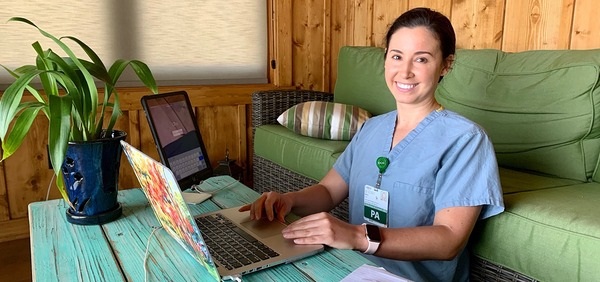
Note: Maria Uhler is no longer with Rush.
Rush has always been committed to helping patients access primary and specialty care services. Telehealth, both scheduled and on-demand, is a crucial way to expand that access, as well as assess patients for COVID-19 concerns.
To help you get to know our Rush virtual providers, we’re featuring them in a Q&A series. Learn more about Maria Uhler, PA-C, below.
Maria is a provider in our on-demand video visit program. Our on-demand video visit providers are the same providers that would treat you in person. Through the on-demand video visit program at Rush, you can get care over video chat for common conditions like the flu or COVID-19 but also coping and stress or return-to-work assessments.
Q: How long have you worked at Rush?
Uhler: I have been working at Rush as a Physician Assistant in the Walk-In Care Center since December 2018.
Q: Where did you work before you started at Rush? Where did you get your Physician Assistant (PA) degree?
Prior to joining Rush, I was employed at the Northwestern Immediate Care practice centers. I got my PA degree at Rush with a third-year specialty in emergency medicine. Overall, my treatment experience has been focused in both urgent care and emergency medicine.
Q: Why do you think telemedicine is important?
I think telemedicine was an important next step for health care to expand and meet the needs of our patients, as those needs have evolved during the COVID-19 pandemic. It has provided a safe way to address the urgent health concerns of patients during a period of heightened anxiety, and has also addressed the need for prompt health care.
While telemedicine is currently the silver lining of the COVID-19 pandemic, being able to offer telemedicine effectively in this time has proven this tool will continue to have broader applications for patients beyond the COVID-19 pandemic.
Telemedicine provides clear enhancements to patient care for common but important health concerns, such as needing a medication refill or checking in after starting a new medication. It can also help to further supplement our goal of proactive and accessible patient care which extends far beyond the challenges of the COVID-19 pandemic.
Q: What do you enjoy about treating patients through virtual care?
My career to date has been in clinic settings. When I began to interact with patients through video, I assumed it would be a less meaningful patient-provider connection — but in a number of ways, it has been the opposite.
Virtual care provides a safe, comfortable space that cannot be replicated in a clinical patient room. I meet patients in their home, in their most familiar of spaces, with all of the trappings of family and pets that emotionally nourish and sustain a patient. At times, there can be underlying anxiety in an unfamiliar hospital or clinic setting. Most of these patients are visiting because they don’t feel well, and the waiting room setting, the empty exam room and being evaluated in a foreign space full of strange equipment is not comforting. Few things about the traditional appointment experience tend to put someone at ease.
With virtual care, speaking with patients on their home “turf,” I can sense a greater level of comfort and ease. It is not unusual to jump online and meet a whole family or talk to someone about a show they are watching when they are waiting for me to come online and I notice they’re watching TV. I’ve been able to meet so many wonderful family members (and pets) over the last few months while practicing virtual care! It has allowed me to connect much more naturally with patients, on a level much different from an exam room.
Q: Can you give a few examples of things you were able to treat over video/through virtual care that you may not expect?
Like learning a new practice in any area, there are patterns and practices that develop in a clinical setting. I think telemedicine initially challenges you to adapt and react creatively quickly. Conducting neurological and musculoskeletal exams initially presented challenges, but I found alternate ways to try and gather the information I needed. It remains important to instill confidence in our patients that we can evaluate them properly, even at a distance.
Another positive aspect of telemedicine is meeting other family members who are part of the patient’s system of care and allowing them to ask questions on how to best help the patient. It feels as though we are working as a “team” and moving forward to get everyone feeling well again.
Finally, a significant plus with telemedicine is instantaneous collaboration with physicians and APPs across all different fields. Patients did not only have access to my knowledge and experience — when I had a question, I could immediately consult with and obtain feedback from additional providers online and provide the most complete and accurate answers and solutions for patients.
Q: What do you like to do when you’re not working?
I love soccer. Prior to the pandemic I played quite a bit. I played in college and was captain of my women’s club team; many of my teammates are teachers and health care providers, so we are all pushing through this together. I will be excited to step back on the field with them once we are able to again.




